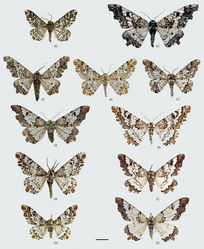Biston thibetaria
| Notice: | This page is derived from the original publication listed below, whose author(s) should always be credited. Further contributors may edit and improve the content of this page and, consequently, need to be credited as well (see page history). Any assessment of factual correctness requires a careful review of the original article as well as of subsequent contributions.
If you are uncertain whether your planned contribution is correct or not, we suggest that you use the associated discussion page instead of editing the page directly. This page should be cited as follows (rationale):
Citation formats to copy and paste
BibTeX: @article{Jiang2011ZooKeys139, RIS/ Endnote: TY - JOUR Wikipedia/ Citizendium: <ref name="Jiang2011ZooKeys139">{{Citation See also the citation download page at the journal. |
Ordo: Lepidoptera
Familia: Geometridae
Genus: Biston
Name
Biston thibetaria (Oberthür, 1886) – Wikispecies link – Pensoft Profile
- Amphidasys thibetaria Oberthür, 1886[1], Études ent., 11: 32, pl. 5, fig. 30. Holotype ♀, China: Sichuan (?), Châpa. (ZFMK)
- Buzura thibetaria : Prout, 1915[2], in Seitz, Macrolepid. World, 4: 360, pl. 19: h.
- Buzura (Blepharoctenia) thibetaria : Wehrli, 1941[3], in Seitz, Gross-Schmett. Erde, 4 (Suppl.): 436.
- Biston thibetaria : Parsons et al., 1999[4], Geometrid Moths of the World, a Catalogue, 1: 88.
Diagnosis
This species is very distinct and is easily recognizable by the thick black lines and yellowish green bands placed basally of the antemedial line of the forewing and distally of the postmedial lines of both wings, the large, black ringed and pale-centred discal spots on both wings, as well as the black-belted abdomen and the fresh yellow anal tuft. The male genitalia of Biston thibetaria are close to those of Biston panterinaria: the apex of the uncus is bifurcated and about four-fifths as long as the basal width; the median process of the gnathos is short and round apically; the valva is broad basally and narrow apically; the ventral margin of the valva is slightly sinuous; the juxta has a deep incision at the middle on the posterior margin; the cornutus is stick-like; a narrow sclerotized band is present on lateral side of the aedeagus. But it can be distinguished from that species by the strongly rounded basal half of the valva. The female genitalia of the species are close to those of Biston panterinaria as follows: the ostium bursae is weakly sclerotized; the ductus bursae is very short; the corpus bursae is curved medially, striated in the posterior half and enlarged at tip; the signum is oval and with marginal spines. It differs in having an oval lamella postvaginalis, which is absent in Biston panterinaria.
Material examineds
CHINA, Sichuan (ZFMK): Sichuan (?), Châpa, 1♂(Syntype). Hubei (IZCAS): Shennongjia, 600–700 m, 17–18.VII., 2.VIII.1998, coll. Ye Chanjuan, 3♂; Xingshan, Longmenhe, 730–1350 m, VI–VII.1993, coll. Song Shimei et al., 11♂1♀; Zigui, Jiulingtou, 220–250 m, 25.VII.1993, coll. Song Shimei, 2♂; Badong, 19.V.1989, 1♂; Hefeng, 650 m, 29.V.1989, coll. Li Wei, 1♂; Lichuan, Xingdoushan, 860 m, 6.VII.1989, coll. Li Wei, 1♂; Xianfeng, 800 m, 2.VI.1989, coll. Li Wei, 1♀. Hunan (IZCAS): Tianpingshan, 12.VIII.1981, 1♂. Fujian (IZCAS): Mt. Wuyi, Sangang, 7.VII.1982, coll. Wang Linyao, 1♂. Guangxi (IZCAS): Longsheng, 10–13.VI.1980, coll. Song Shimei and Wang Linyao, 4♂. Sichuan (IZCAS): Barkam, 2600 m, 21.VIII.1983, coll. Chai Huaicheng, 1♂; Luding, Moxi, 600–1900 m, 11–17.VI.1983, coll. Chai Huaicheng and Wang Shuyong, 3♂; Luding, Guzanjiangju, 1635 m, 21.V.2009, coll. Liang Hongbin and Wang Zhiliang, 1♂2♀; Batang, 1975, 9♂; Dukou, Pingdi, 5–22.VI.1987, coll. Zhang Baolin, 13♂; Huili, 23–29.VII.1974, coll. Han Yinheng, 2♂1♀; Yanyuan, Jinhe, 1230 m, 28.VI.1984, coll. Chen Yixin, 1♂. Guizhou (IZCAS): Meiyun, 6.IV.1978, coll. Xia Huai’en, 1♀. Yunnan (IZCAS): Lijiang, 22–23.V.1980, 7♂1♀; Lijiang, Yushuizhai, 2680 m, 21.VI.2009, coll. Qi Feng, 1♂; Qujing, 3–20.VII.1982, coll. Wang Linyao and Song Shimei, 4♂; Luoci, 21.VI.1982, coll. Song Shimei, 1♂; Yongsheng, Liude, 2250m, 9.VII.1984, coll. Liu Dayun, 1♂. More material from Hubei, Sichuan, Yunnan, Tibet in coll. ZFMK.
Distribution
China (Henan, Zhejiang, Hubei, Hunan, Fujian, Guangxi, Sichuan, Guizhou, Yunnan, Tibet).
Remarks
The female which Oberthür (1886[1], pl. 5, fig.30) figured, is generally considered to be the holotype of thibetaria. However, he indirectly mentioned a larger number of specimens in his original description, by writing: “some specimens have the wings crossed by curved medial lines which cut through the discoidal spots” (translated from French). The female is part of the ZFMK collection, as already mentioned by Wehrli (1941)[3], but all other syntypes are not. It is well possible that they have been transferred to The Natural History Museum, London, which keeps a large part of the Charles Oberthür collection. If these specimens will be found existing, the female will lose its holotype status. Eight specimens of thibetaria from several Sichuan localities in the ZFMK collection bearing the typical printed labels of Oberthür have been collected later, in the years following the description of thibetaria, thus they do not belong to the syntype series.
Taxon Treatment
- Jiang, N; Xue, D; Han, H; 2011: A review of Biston Leach, 1815 (Lepidoptera, Geometridae, Ennominae) from China, with description of one new species ZooKeys, 139: 45-96. doi
Other References
- ↑ 1.0 1.1 Oberthür C (1886) Nouveaux Lépidoptères du Thibet. Études d’Entomologie 11: 13-38.
- ↑ Prout L (1912–1916) The Palaearctic Geometrae. In: Seitz A (Ed) The Macrolepidoptera of the World. Vol. 4, Verlag A. Kernen, Stuttgart, 1–479, pls. 1–25.
- ↑ 3.0 3.1 Wehrli E (1938–1954) Subfamilie: Geometrinae. In: Seitz A (Ed) Die Grossschmetterlinge der Erde. Vol. 4 (Supplement), Verlag A. Kernen, Stuttgart, 254–766, taf. 19–53.
- ↑ Parsons M, Scoble M, Honey M, Pitkin L, Pitkin B (1999) The catalogue. In: Scoble M (Ed). Geometrid moths of the world: a Catalogue (Lepidoptera, Geometridae). CSIRO, Collingwood: 1-1016.
Images
|




